Back Trolling For Salmon: A Complete How-To Guide
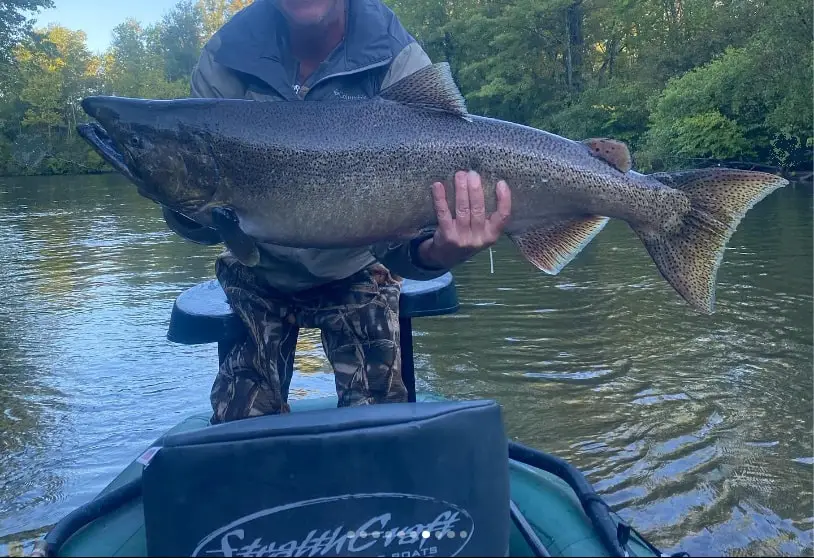
Back Trolling Techniques for Salmon Fishing: Expert Strategies for More Strikes
I’ve been practicing the art of back trolling for salmon for more than two decades and will tell you the key components of plug fishing for Salmon is to move slowly, take your time, put the plugs out the same distance, use the same rods, same reels, same lines, and same set up so they all run the same.
I’ve packed this article with information with a range of tips and tactics, both for beginners and advanced anglers. Everything from the right size fishing line, how to fish plugs, to setting the hook is covered here.
Also included are three back trolling rig setups.
Understanding the Approach of Back Trolling for Salmon
Back trolling is an angling technique used to present lures to salmon from a boat while very slowly moving downstream. It covers more water and is used on larger rivers that can accommodate a boat. The boat operator needs to maintain precise control over your boat, use the right lures, set your lure depths, and know the best fishing locations.
This method is different than Back Bouncing for salmon.
Back Trolling Boats
Plug fishing for salmon on larger rivers is best done from a small to mid-sized motorized fishing boat. Other anglers and guides will use a drift boat, jet sled, pontoon boat, or even a raft for smaller rivers.
Boat Control Is Key
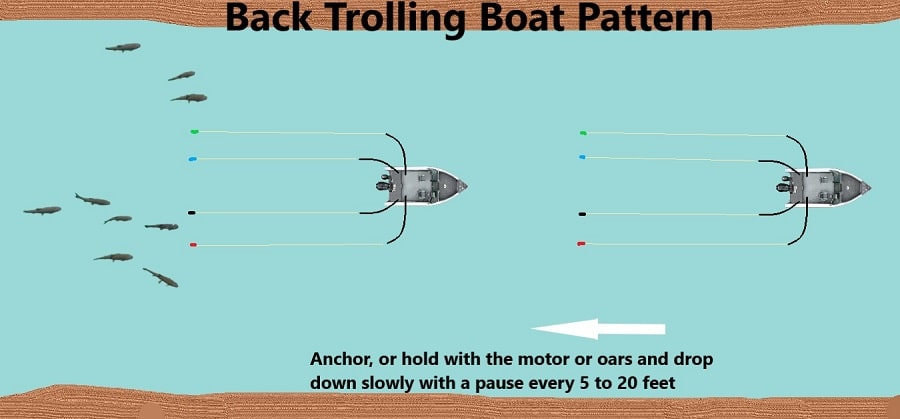
Proficiency in boat control remains pivotal if you want to catch more fish. Seasoned salmon fishermen are adept at positioning and maneuvering their boats, aligning them with the target strike zones while they slowly slip downstream slightly slower than the current.
- Gas Motor: A gasoline-powered motorboat works wonders in both large and small river environments. It facilitates precise positioning, lateral movement, and gentle downstream navigation of the boat and its lure.
- Electric Trolling Motor with Auto Pilot: Electric motors equipped with auto-pilot capabilities enable you to keep your boat steady in position and maneuver it sideways or downstream with minimal noise.
- Oars: Oars are a reliable tool for maintaining position or shifting your boat’s location as needed. They provide valuable flexibility when controlling your vessel.
Drift Boats, Pontoon Boats, and Rafts
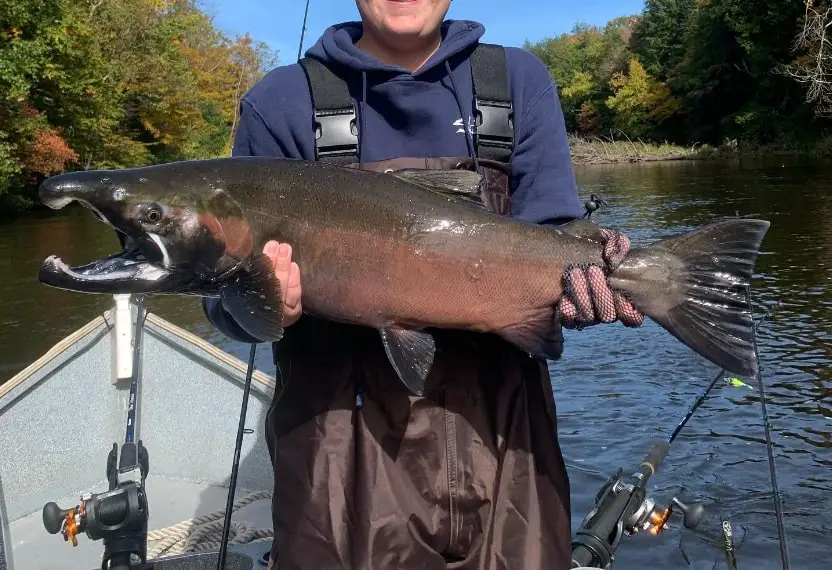
Drift boats and inflatable rafts have the advantage of portability and the ability to navigate through very shallow waters. These riverboats also allow for a stealthy approach. To keep these boats steady and in position, the boat operator uses oars or an anchor.
I’ve even observed some fishermen outfitting these boats with electric motors.
The Art of Salmon Back Trolling: Step-by-Step
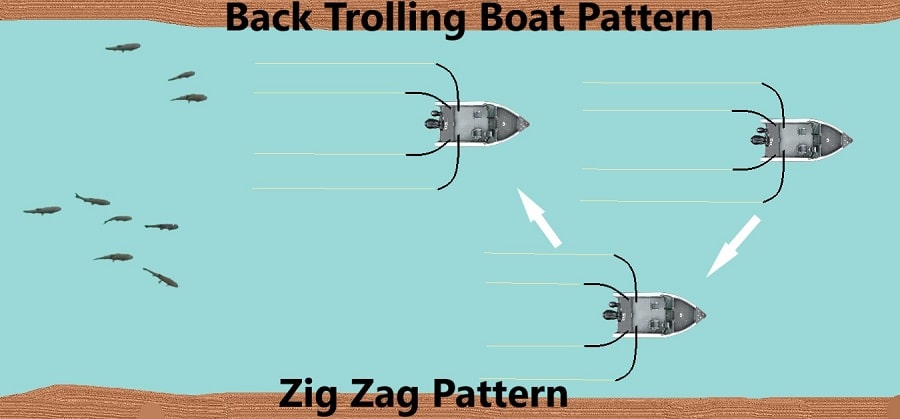
- Anchoring and Positioning: Start by positioning your boat far enough upstream of the potential fish zone so that once your plugs are out, you need to back into the fish. Anchor the boat for this, or use your motor to maintain your position.
- Selecting Lures: Opt for lures based on the section of the river you are about to fish. This means the desired depth and speed. Use lures that can run 1 to 3 feet above the riverbed. Deploy the lures at the appropriate distance for the running depth.
- Ready Your Fishing Rods: Prepare your fishing rods by placing them in rod holders or holding them manually.
- Maneuver Your Boat: Begin the back trolling process by gradually moving the boat into the desired position. If you’re fishing in wider rivers, consider controlled side-to-side movements to maximize coverage before dropping slowly down the river.
- Slow Descent: Slowly lower the boat’s position by 5 to 10 feet and pause for a few seconds. I often adopt a side-to-side drop-down technique in wide rivers or employ a slow zig-zag pattern to ensure I cover all the water.
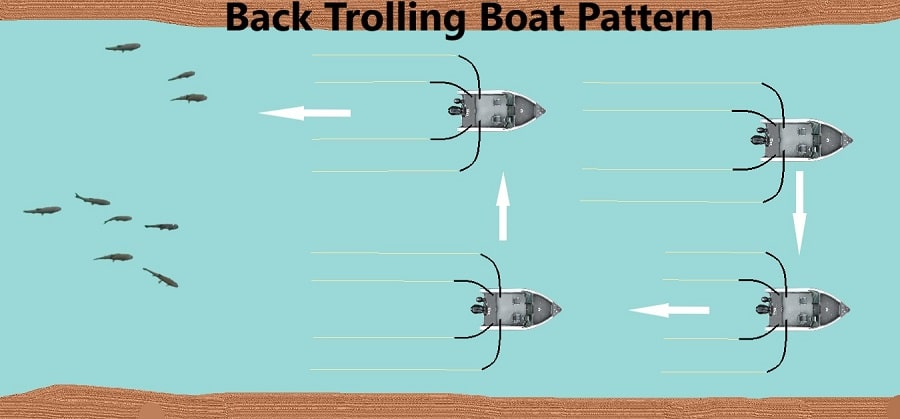
Essential Gear for Salmon Back Trolling
Fishing Rods: Your choice of rod should fall within the 8 to 10-foot range, which enables you to spread the lure further off the side of the boat. For Smaller boats like a drift boat go with 8 to 8’6″. For larger boats and for fishing big kings, fishermen will use 9 and 10.5-foot rods.
A rod with a stiffer butt section and a softer and more sensitive rod tip is ideal, and a line rating of 8 to 17 pounds is good for Coho salmon fishing and Chum fishing or for Great Lakes king salmon. Use a rod with a line rating of 10 to 20 pounds for big west coast king salmon.
Favorite rods for back trolling include:
- Lamiglas Battle Glass Salmon & Steelhead Rod
- or the very popular glass tip rod the Lamiglas XCC Bait & Trolling Casting Rod
- Lamiglas XCC Kwik Series Salmon & Steelhead Rod.
Reels: Most anglers and guides prefer baitcaster reels or line counter reels to gauge lure depth and placement accurately. Alternatively, spinning reels are viable options. Use the right sized reel with generous line spool capacity and a smooth drag.
Fishing Main Line: Choose a mainline that is between 30 to 40-pound monofilament, 50 to 65-pound braided line, or 30 40-pound fluorocarbon, based on your preferences.
Leader: When using monofilament or braided line, attach a 40-pound fluorocarbon leader spanning 3 to 5 feet.
Rod Holders: Rod holders come in handy, especially in regions where regulations permit using two or more rods per angler.
Terminal tackle: Your gear and rig will include a snap swivel to attach the lure, and a barrel swivel can also be used to attach a leader. Some fishermen will add an 8mm bead above the top barrel swivel to protect the rod tip eye. For some rigs, a three-way swivel is used, especially when using a weight.
Exploring Effective Lures for Salmon Fishing
While a variety of lures can be effective when targeting salmon, only a select few truly excel in the realm of back trolling. Here are some insights into choosing lures that increase your chances of success:
Preferred Lure Colors: The choice of lure color depends upon factors like river conditions, including water height, clarity, and current velocity. Varieties of dark hues like purple and black are sometimes better in gin-clear water. In less clear water, flashy options such as silver, silver/blue, and silver/green, are generally reliable choices.
Bright-colored lures in pink, orange, chartreuse, red, and white can sometimes be effective, especially in dirtier water.
Ideal Lure Sizes: Optimal lure sizes typically range between 3 to 5 inches. Sticking to this size range works well across various river conditions. However, in murkier, higher waters, consider experimenting with large plugs and lures up to 6 inches.
Crankbaits: Although mostly used to troll or cast with, deep diving or mid-depth crankbaits can be very effective to back troll behind the boat. Lures like Luhr Jensen Hot Shots, Brad’s Wigglers, and Storm Wiggle Warts, equipped with rattles to attract salmon, often top the list of favorites.
Plugs: Back trolling plugs for salmon is a tried-and-true approach due to the enticing wobbling motion that entices salmon strikes. When fishing plugs, the best lures are Kwikfish K13 to K16, Flat Fish, Mag Lips, Brad’s KillerFish, and even Lyman plugs or Brad’s Super Cut Bait Plug.
Spoons and Spinners: While not as frequently used, spoons like a Brads Wobbler and spinners can also be effective, particularly when sinking lures are advantageous.
Spin-N-Glo and Bait: Salmon anglers will also use a bait at times, especially in clear water. Using a Spin-N-Glo with a trailing bait like a Coon-Shrimp or Atlantic Prawn will work really to catch salmon.
Guide Tip: Tightly wrap plugs with sardine, tuna, tuna belly, sand shrimp, or herring strip. Bait should be tight to the belly of the lure and small enough that it doesn’t affect the action of the lure. Tune the lure if needed.
See Best Lures For Salmon Fishing.
Fine-Tuning Your Plugs for Optimal Performance
A valuable tip is to inspect and fine-tune your lure before casting it into the water or after hooking a fish. You must make sure it is working properly.
By holding the lure just beneath the water’s surface and observing its behavior, you can determine if adjustments are necessary. Slight modifications to the eye of the lure can ensure a straight running lure through the water. Straight running lures mean more successful days on the water. This should be done after wrapping plugs with bait.
Handheld Rods Versus Rod Holders
The choice between holding your rod or putting the rod in a rod holder presents itself frequently.
While holding the rod by hand offers the advantage of promptly sensing fish strikes and thumbing the spool for a stronger hookset, it may not always be the best choice and can lead to lost fish because most anglers set the hook too fast. See Setting the hook below.
In scenarios where multiple rods are in play or when your hands are occupied with steering or oar use, rod holders become indispensable.
Setting the Drag, and Setting The Hook
Set your drag light enough that the salmon can turn and pull the line out. This gives a better hookset in the corner of the mouth. It also gets the salmon downriver and away from the other plugs, which means fewer tangles.
Guide Tip: Don’t rush to pull the salmon to the boat, wait until all the other lines are out of the water first.
I’ve heard many guides say the same thing. Always hesitate on the hookset and only set when you feel the weight of the fish or the line is peeling out.
Salmon will often bump a lure multiple times. If the lure gets hit and the fish is gone, often they will bump it again and then again before they actually grab it.
When you pull the rod out of the rod holder, keep the rod low to the water and out to the side, and reel hard for the hookset. Don’t quick snap set! The longer you wait on the grab, the greater your chances are of hooking the fish.
Strategic Fishing Locations for Plugs and Lures
Salmon typically gravitate toward deeper waters when the water is clear, and they will follow travel routes through these deeper trenches and deep holes, which are prime fishing spots.
Salmon can push close to the shoreline into water less than 5 feet deep when the water is high or muddy, and find slower water when the water is higher.
Optimal fishing spots include travel routes, areas downstream of shallows and rapids, elongated pools in corners, and adjacent to substantial underwater structures.
Guide Tip: Don’t fish boiling water or upwelling water. This type of water pushes your lures up and can also push salmon up which they don’t like so they won’t hold or use this type of water.
Top Tips for Enhanced Salmon Back Trolling
- Varied Lure Action: Employ occasional pulling, ripping, and twitching of the lure to create movement, attracting fish that might be following but hesitant to strike. Silver salmon are known chasers, so periodically pulling the plug upriver with quick line retrievals of 3 to 8 feet can provoke strikes effectively. NOTE: Not all lures work well with fast upriver pulling or retrieving.
- Sharp Hooks: Maintain razor-sharp hooks for secure hooksets. Sharp hooks ensure that the salmon is securely hooked and minimize instances of lost fish.
- Lure Depth Mastery: Mastering lure depth is a crucial skill. Observe the pulsation of your rod tip to determine if the lure is running correctly above the riverbed. A pulsating tip indicates proper wobbling action above the bottom, while erratic or halted movements suggest bottom contact or debris on the plug.
- Proper Lure Spacing: Optimize your plug arrangement by employing shorter rods on the inside and longer rods on the outside, or angling the rods at varying angles also increases your coverage area.
- Even Lure Distribution: When using two or more plugs simultaneously, keep them all in a line, guys call this a wall of plugs. Strive for uniform distances between them as well. Portable line counters or having the lines enter the water at the same line are viable strategies to maintain even lure distribution.
- Bank Fishermen: Courtesy goes a long way. If possible, do not fish close to or in front of bank anglers. Also, boats that go ripping up or down the river past fishermen spook their fish and make it harder for them to catch fish. Slow down and drift past bank anglers whenever possible.
- Guide Tip: If you wrap bait onto your hook, remove the top hook and use only the rear hook. The rear hook should be changed to a large single-hook attached to the back with a split ring and swivel.
- Fishing Deep Water: When fishing very deep water that is over 20 feet, use a jet diver or a Brad’s Magnum diver to pull your bait down to the bottom. You will see guys using these on large rivers like the Skeena, Niagara River, Columbia River and the Kenai River in Alaska. These divers dive deep and pull your lures down with them. I use a 12-inch dropper line from the jet driver.
- Flat Line Fishing: Flat line fishing is best when fishing in water 10 feet or less. No weights or divers are required, just a good plug that dives and wobbles well.
These tips and methods are basically the same as I used when back trolling for Steelhead.
Innovative Anchoring Solutions For Back Trolling For Salmon
Chain Anchor: A heavy chain anchor enables the fisherman to lift a portion of the anchor, allowing the rest to drag. This method imparts a slow downstream movement to the boat, minimizing the risk of entanglements.
Electric Anchor: In most situations, using an electric anchor offers several advantages, including hands-free fishing and control of the boat’s direction and movement. This approach proves particularly beneficial in colder weather so you are not getting your hands wet and cold.
3 Back Trolling Rigs For Salmon
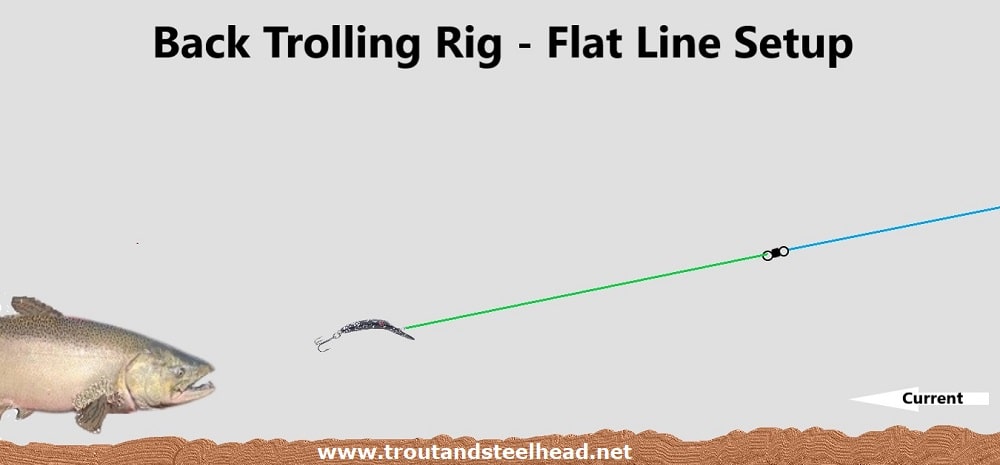
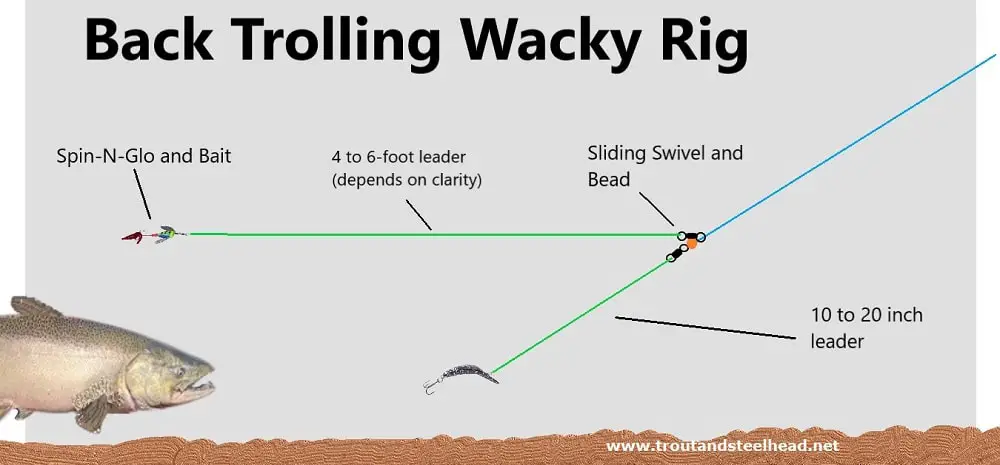
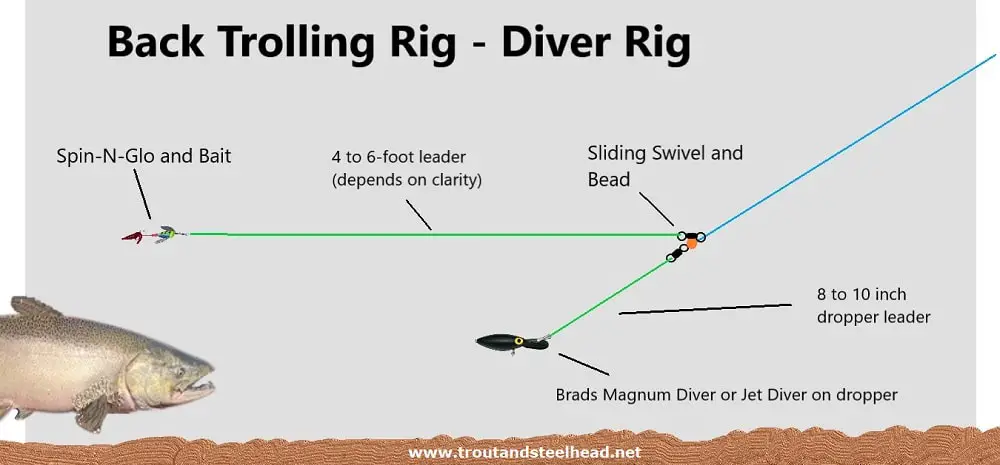
Back Trolling For Salmon Q&A: Your Questions Answered
If you have questions, insights, or tips to share regarding back trolling for salmon, feel free to leave a comment in the section below.
TightLines,
Graham
